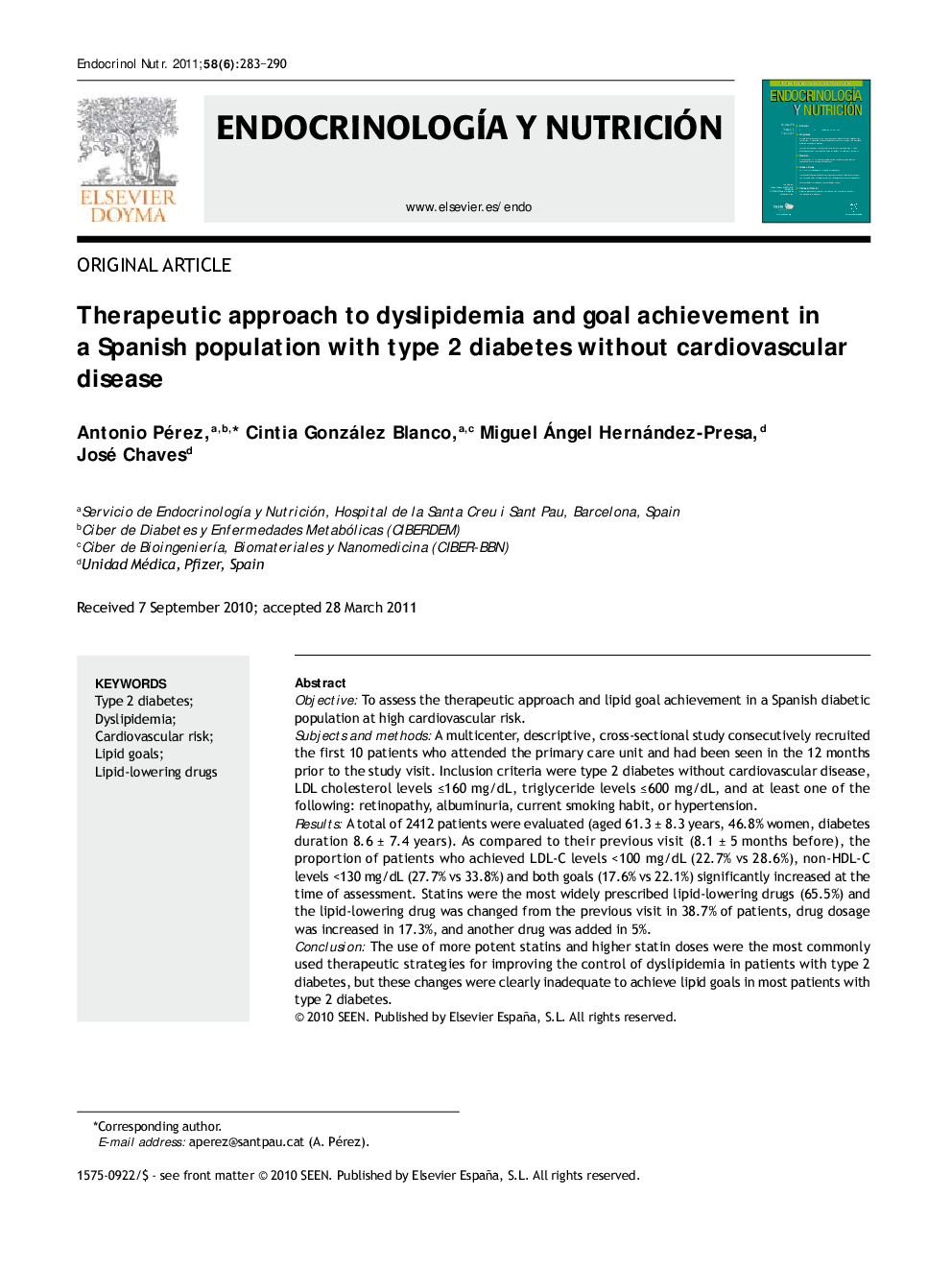| کد مقاله | کد نشریه | سال انتشار | مقاله انگلیسی | نسخه تمام متن |
|---|---|---|---|---|
| 3267380 | 1207988 | 2011 | 8 صفحه PDF | دانلود رایگان |

ObjectiveTo assess the therapeutic approach and lipid goal achievement in a Spanish diabetic population at high cardiovascular risk.Subjects and methodsA multicenter, descriptive, cross-sectional study consecutively recruited the first 10 patients who attended the primary care unit and had been seen in the 12 months prior to the study visit. Inclusion criteria were type 2 diabetes without cardiovascular disease, LDL cholesterol levels ≤160 mg/dL, triglyceride levels ≤600 mg/dL, and at least one of the following: retinopathy, albuminuria, current smoking habit, or hypertension.ResultsA total of 2412 patients were evaluated (aged 61.3 ± 8.3 years, 46.8% women, diabetes duration 8.6 ± 7.4 years). As compared to their previous visit (8.1 ± 5 months before), the proportion of patients who achieved LDL-C levels <100 mg/dL (22.7% vs 28.6%), non-HDL-C levels <130 mg/dL (27.7% vs 33.8%) and both goals (17.6% vs 22.1%) significantly increased at the time of assessment. Statins were the most widely prescribed lipid-lowering drugs (65.5%) and the lipid-lowering drug was changed from the previous visit in 38.7% of patients, drug dosage was increased in 17.3%, and another drug was added in 5%.ConclusionThe use of more potent statins and higher statin doses were the most commonly used therapeutic strategies for improving the control of dyslipidemia in patients with type 2 diabetes, but these changes were clearly inadequate to achieve lipid goals in most patients with type 2 diabetes.
ResumenObjetivoEvaluar la estrategia terapéutica y el grado de consecución de los objetivos lipídicos en la población española con diabetes y alto riesgo cardiovascular.Sujetos y métodosEstudio descriptivo, transversal y multicéntrico con inclusión mediante muestreo consecutivo de los 10 primeros pacientes que acudieron a consulta de Atención Primaria y que hubieran sido visitados durante los 12 meses previos al estudio. Se incluyeron pacientes con diabetes tipo 2 sin enfermedad cardiovascular, concentraciones de colesterol LDL (cLDL) ≤ 160 mg/dl y triglicéridos ≤ 600 mg/dl, y al menos uno de los siguientes: retinopatía, albuminuria, tabaquismo actual o hipertensión.ResultadosSe evaluaron 2.412 pacientes (edad: 61,3 ± 8,3 años; 46,8% mujeres, duración de la diabetes de 8,6 ± 7,4 años). En comparación con la visita previa (8,1 ± 5 meses antes), en el momento de la evaluación, la proporción de pacientes con cLDL < 100 mg/dl (22,7 vs 28,6%), c-noHDL < 130 mg/dl (27,7 vs 33,8%) y la combinación de ambos (17,6 vs 22,1%) aumentaron significativamente. Las estatinas eran los fármacos hipolipemiantes más prescritos (65,5%) y, desde la visita previa, en el 38,7% de los pacientes se cambió el fármaco hipolipemiante, en el 17,3% se aumentó la dosis y en un 5% se añadió otro fármaco.ConclusiónLa utilización de estatinas de mayor potencia y el incremento de la dosis es la estrategia terapéutica más utilizada para mejorar el control de la dislipemia en los pacientes con diabetes tipo 2, pero estos cambios resultan claramente insuficientes para alcanzar los objetivos lipídicos en la mayoría de los pacientes con diabetes tipo 2.
Journal: Endocrinología y Nutrición (English Edition) - Volume 58, Issue 6, 2011, Pages 283-290